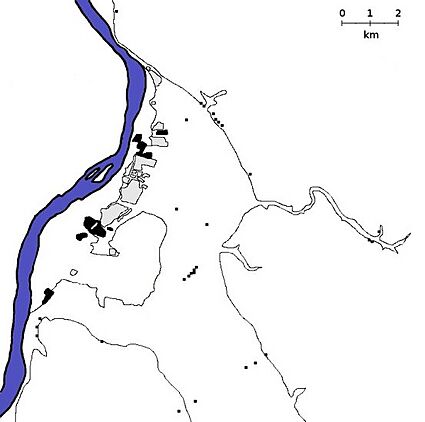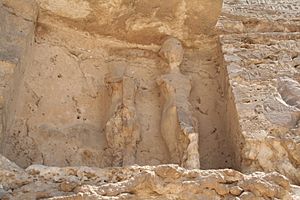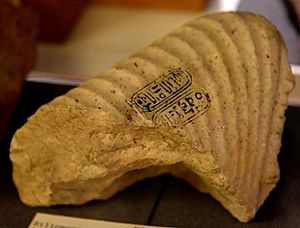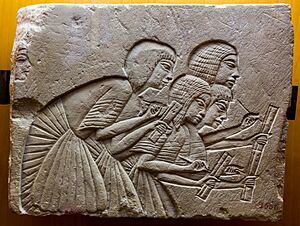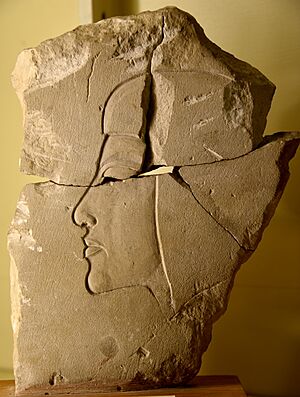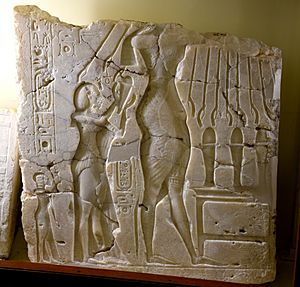Amarna facts for kids
|
العمارنة
|
|
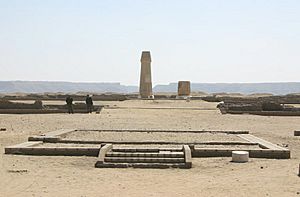
The Small Aten Temple at Akhetaten
|
|
| Alternative name | El-Amarna, Tell el-Amarna |
|---|---|
| Location | Minya Governorate, Egypt |
| Region | Upper Egypt |
| Coordinates | 27°38′43″N 30°53′47″E / 27.64528°N 30.89639°E |
| Type | Settlement |
| History | |
| Builder | Akhenaten |
| Founded | Approximately 1346 BC |
| Periods | Eighteenth Dynasty of Egypt, New Kingdom |
Amarna ( Arabic: العمارنة, romanized: al-ʿAmārna) is an ancient Egyptian archaeological site. It holds the remains of Akhetaten, a capital city built during the late Eighteenth Dynasty of Egypt. The city was started in 1346 BC by Pharaoh Akhenaten. It was left empty soon after he died in 1332 BC. The ancient Egyptians called the city Akhetaten or Akhetaton. This name means "the horizon of the Aten".
The site is on the east side of the Nile River. Today, it is in the Egyptian area of Minya. It is about 58 km (36 mi) south of al-Minya. It is also 312 km (194 mi) south of Cairo, Egypt's capital. Luxor (where the old capital, Thebes, was) is 402 km (250 mi) to the south. The city of Deir Mawas is directly to its west. On the east side of Amarna, there are several modern villages. The main ones are l-Till in the north and el-Hagg Qandil in the south.
The area was busy from the Amarna Period until the later Roman era.
Contents
What's in a Name?
The name Amarna comes from the Beni Amran tribe. This tribe lived in the area and started some settlements. The old Egyptian name for the city was Akhetaten.
An English expert on Egypt, Sir John Gardner Wilkinson, visited Amarna in the 1820s. He thought it was a place called Alabastron.
Akhetaten: The City of Akhenaten
The land where the city was built was mostly empty. Akhenaten said this city was the Aten's "first home." He said the Aten made it for himself to rest there.
The Royal Wadi (a valley) looked like the hieroglyph for horizon. This might have shown that it was the right place to build the city.
Pharaoh Akhenaten built this city as his new capital. He dedicated it to his new religion, which worshipped the Aten. Building started around Year 5 of his rule (1346 BC). It was likely finished by Year 9 (1341 BC). But it became the capital two years earlier. To build fast, most buildings were made of mudbrick and painted white. Important buildings had local stone on their outside.
This is the only ancient Egyptian city that still shows many details of its original layout. This is because it was almost completely left empty. This happened soon after the royal government of Tutankhamun moved back to Thebes (modern Luxor). The city seemed to be used for about ten more years after Akhenaten's death. A shrine to Horemheb shows it was partly used when he began his rule. But it was mainly used as a source for building materials for other places. Once left, it stayed empty until Roman people settled near the Nile.
Amarna was built quickly. It covered about 8 mi (13 km) of land on the east side of the Nile River. On the west side, land was set aside to grow food for the city's people. The whole city is surrounded by 14 boundary stelae (carved stone slabs). These stelae describe Akhenaten's rules for building this new capital city.
The oldest dated stele is Boundary stele K. It is from Year 5, month 8, day 13 of Akhenaten's rule. Most of the original 14 stelae are badly worn. This stele tells about Akhenaten founding the city. It says the pharaoh wanted several temples for the Aten built there. He also wanted royal tombs in the eastern hills of Amarna for himself, his main wife Nefertiti, and his oldest daughter Meritaten. He also clearly ordered that he be buried in Amarna after he died. Boundary stele K describes the events celebrated at Amarna:
His Majesty rode in a great chariot of electrum, like the Aten when He rises on the horizon and fills the land with His love. He took a good road to Akhetaten, the first place, which [the Aten] had made for Himself to be happy in. It was His son Wa'enrē [Akhenaten] who built it for Him as His monument when His Father told him to make it. Heaven was happy, the earth was glad, every heart was filled with joy when they saw him.
This text then says Akhenaten made a great offering to the god Aten. This is shown in the pictures on the stelae. In these pictures, he stands with his queen and oldest daughter in front of an altar. The Aten shines on them, making their bodies young again with its rays.
City Layout and Areas
The city's ruins are on the east bank of the Nile. They stretch roughly north to south along a "Royal Road." This road is now called "Sikhet es-Sultan." The royal homes are mostly in the north, in an area called the North City. The central part has administrative and religious buildings. The south of the city has residential areas.
North City

If you came to Amarna from the north by river, the first buildings past the northern boundary stele would be the North Riverside Palace. This building went all the way to the water. It was likely where the royal family lived most of the time. The Northern Palace is also in the North City area. It was the main home of the royal family. Between this and the central city, the Northern Suburb was a rich area with large houses at first. But the houses became smaller and poorer the further they were from the road.
Central City
Most of the important official and religious buildings were in the central city. The Great Temple of the Aten and the Small Aten Temple were used for religious events. Between these, the Great Royal Palace and Royal Residence were the king's official homes. They were connected by a bridge or ramp. Behind the Royal Residence was the Bureau of Correspondence of Pharaoh. This is where the Amarna Letters were found.
This area was probably the first part of the city to be finished. It was built in at least two stages.
Southern Suburbs
To the south of the city was the area called the Southern Suburbs. It had the large homes of many powerful nobles. These included Nakhtpaaten (the Chief Minister), Ranefer, Panehesy (High Priest of the Aten), and Ramose (Master of Horses). This area also had the workshop of the sculptor Thutmose. The famous bust of Nefertiti was found there in 1912.
Further south was Kom el-Nana, a walled area. It was probably a sun-temple. Then there was the Maru-Aten. This was a palace or sun-temple. It was first thought to be built for Akhenaten's queen Kiya. But after she died, her name and pictures were changed to those of Meritaten, his daughter.
City Edges
The Boundary Stelae surround the city and show its size. These are carved rocks on the cliffs on both sides of the Nile. They are a main source of information about how the city was founded.
Away from the city, Akhenaten's Royal necropolis (burial ground) was started. It was in a narrow valley east of the city, hidden in the cliffs. Only one tomb was finished. It was used by an unnamed Royal Wife. Akhenaten's tomb was quickly used for him and likely Meketaten, his second daughter.
In the cliffs north and south of the Royal Wadi, the city's nobles built their Tombs.
Life in Ancient Amarna
Much of what we know about Amarna's start comes from the boundary stelae. There are 13 known stelae around the city's edge. They are carved into the cliffs on both sides of the Nile (10 on the east, 3 on the west). They record events from Akhetaten, from its founding until just before it fell.
To move from Thebes to Amarna, Akhenaten needed the army's help. Ay, one of Akhenaten's main advisors, had a lot of power in the army. His father Yuya had been an important military leader. Also, everyone in the army had grown up together. They had been part of Egypt's richest and most successful time under Akhenaten's father. So, loyalty in the army was strong.
Religion in Amarna
Akhenaten's changes are often thought to be about worshipping only one god (monotheism). Or, more accurately, worshipping one main god while still believing in others (monolatrism). But archaeological finds show that other gods were also honored. This happened even at the center of the Aten cult. If not officially, then at least by the people living and working there.
... at Akhetaten itself, recent excavations by Kemp (2008: 41–46) have shown the presence of objects that depict gods, goddesses and symbols that belong to the traditional field of personal belief. So many examples of Bes, the strange dwarf figure who kept away evil spirits, have been found. Also, the goddess-monster, Taweret, part crocodile, part hippopotamus, who was linked to childbirth. In the royal workmen's village at Akhetaten, stelae dedicated to Isis and Shed have been found (Watterson 1984: 158 & 208).
Amarna Art Style
The Amarna art style was different from older Egyptian art. It showed people more realistically. It included everyday scenes, like the royal family showing affection or playing with their children. Women were no longer shown with lighter skin than men. The art also looked very real, sometimes almost like a cartoon.
The worship of Aten was later called the Amarna heresy and stopped. But this new art style had a longer-lasting effect.
Finding and Digging Up Amarna
Early Discoveries (1700s-1800s)
The first time a Westerner mentioned the city was in 1714. This was by Claude Sicard, a French priest traveling in the Nile Valley. He described the boundary stela from Amarna. Like much of Egypt, Napoleon's scientists visited it in 1798–1799. They made the first detailed map of Amarna. This map was later published between 1821 and 1830.
After this, European exploration continued in 1824. Sir John Gardiner Wilkinson explored and mapped the city's remains. The copyist Robert Hay and his surveyor G. Laver visited the area. They dug out several Southern Tombs from sand in 1833. They also recorded the carvings.
A German expedition led by Richard Lepsius visited the site in 1843 and 1845. They recorded the visible monuments and layout of Amarna. They used drawings and paper copies. Their findings were published between 1849 and 1913. This included a better map of the city. These early records are very important. Many of these remains were later destroyed or lost.

The Amarna Letters
In 1887, a local woman digging for fertilizer found a hidden group of over 300 cuneiform tablets. These are now known as the Amarna Letters. These tablets were diplomatic messages from the Pharaoh. They were mostly written in Akkadian. This was the common language used for such messages in the Late Bronze Age of the Ancient Near East. This discovery showed how important the site was. It led to more exploration.
Digging Up the King's Tomb
Between 1891 and 1892, Alessandro Barsanti found and cleared the king's tomb. Local people probably knew about it from about 1880. In 1891 and 1892, Sir Flinders Petrie worked for one season at Amarna. He dug mainly in the Central City. He explored the Great Temple of the Aten, the Great Official Palace, the King's House, the Bureau of Correspondence of Pharaoh, and several private homes. Petrie's digs found more cuneiform tablets. He also found remains of glass factories. He found many pieces of faience, glass, and pottery when sifting through palace trash. By quickly publishing his findings, Petrie helped create more interest in the site.
20th Century Digs
The artist Norman de Garis Davies published drawings and photos of private tombs and boundary stelae from Amarna from 1903 to 1908.
From 1907 to 1914, the Deutsche Orientgesellschaft expedition, led by Ludwig Borchardt, dug widely in the North and South suburbs. The famous bust of Nefertiti was found there. It was found in the workshop of the sculptor Thutmose. The start of World War I in August 1914 stopped the German digs.
From 1921 to 1936, an Egypt Exploration Society expedition returned to Amarna. They focused on religious and royal buildings.
In the 1960s, the Egyptian Antiquities Organization (now the Egyptian Supreme Council of Antiquities) did more digs at Amarna.
21st Century Digs
Exploring the city continues today. It is currently led by Barry Kemp (a professor from the University of Cambridge, England). From 2005 to 2013, the Amarna Project dug at a cemetery for ordinary people. This cemetery was near the southern tombs of the Nobles.
See also
 In Spanish: Amarna para niños
In Spanish: Amarna para niños



